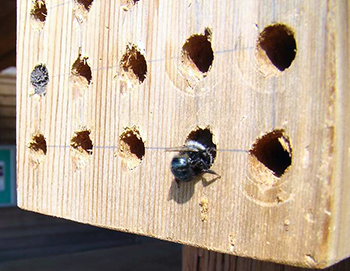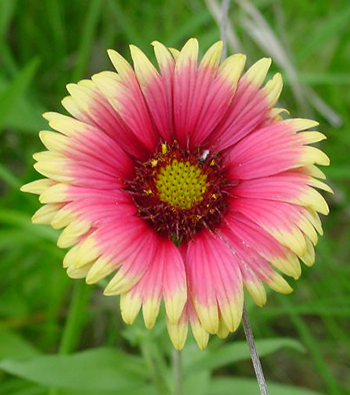Pollinator Protection Starts at Home
Return to Insect Agent Articles

You may have read about the declining population of our pollinators. The decline is happening with our honeybees, butterflies and other species. The butterflies and honeybees grab the headlines. Often left out of the news is the decline of what many call the unsung pollination heroes — the native bees, wasps and flies. These are not glamorous and are usually left out of the discussion.
These valuable pollinators include two groups of insects. Social bees, like honeybees and bumblebees, live in colonies. Solitary bees include excellent pollinators such as the green sweat bee, leaf-cutter bee, and the orchard mason bee. This group, as the name implies, lives alone, foraging for pollen and nectar and in the process pollinating many flowers and crops. These various species of bees pollinate more flowers than any other group of insects, yet their demise is seldom mentioned. Why? Because they are small, not highly attractive, and, quite frankly, many people hear the word ‘bee’ have negative thoughts.
Native bees such as the mason bee are more efficient at pollination than honeybees. It takes about two hundred and fifty mason bees to pollinate one acre of apple trees. It would take approximately ten thousand to two hundred fifty-thousand honeybees to accomplish the same task. So what can we do to help preserve and increase this crop of pollinators? Here are a couple of easy ideas.
Tips for Increasing Native Bee Populations
 Go native- Add more native plants to your garden. Pollinators are native to our region and best adapted to feed on native plants. They have evolved together. They like nectar on our valuable crops but also daisy-like flowers such as gaillardia, asters and sunflowers, to name a few. A diverse garden with many plants is more bee-friendly.
Go native- Add more native plants to your garden. Pollinators are native to our region and best adapted to feed on native plants. They have evolved together. They like nectar on our valuable crops but also daisy-like flowers such as gaillardia, asters and sunflowers, to name a few. A diverse garden with many plants is more bee-friendly.
Keep it a little messy- It’s not just the plants growing in your garden that help the population. There are simple cultural practices at work, or should I say require less work. Bees like it a little messy. Most of our native bee species nest underground. Avoid using weed fabric and reduce the amount of mulch used in the garden. In fact, leave some area open as this provides the best nesting locations. Remember, a sunny spot is ideal.
Native bees are also attracted to small piles of branches, twigs, and rotting logs. Some species will move into the cracks and crevices and make nesting sites for the next generation. Instead of removing all the dead debris, create small piles throughout the garden that are attractive to many of the solitary bees.
Go Pesticide Free- A bee-friendly garden eliminates or dramatically reduces the use of all pesticides, including insecticides, herbicides and fungicides. While these products are useful in controlling harmful pest problems, they are also detrimental to our pollinator bees. Usually, in a well-planned garden having a diverse planting, pest problems rarely arise, as the natural balance found in nature keeps most issues in check. Even if an outbreak occurs, most healthy and happy plants will recover without intervening.
Keep in mind, organic pesticide use should also be limited. Just like chemical controls, many of the organic products impact the population of beneficial insects. Most are not formulated to target only the bad guy. In the process of controlling the damaging pest, they also reduce the population of the good guy.
Add a Pollinator Bee Box- 
We have all heard of birdhouses, but have you thought of installing bee houses? Just like a birdhouse is used for nesting, the same holds for the bee house. Bee houses do not have to be fancy. These man-created nesting boxes borrow from the gardening practice of leaving twigs, branches and decaying wood in the garden that have small holes, perfect for egg-laying.
Bee houses can be made from untreated lumber or a log. Simply drill various size holes ranging from an eighth to a quarter-inch in size in the wood. The holes should be several inches or more deep for best results. Hang on a fence or post in a sunny location and soon the native bees will come. Other box ideas include paper drinking straws layered in a tin can or even hollow perennial debris tied together and hung from a tree.
Solitary bee activity can be spotted in the nesting box as the holes will become plugged with a mud-grass-like mixture. The bees will lay eggs in the holes, covering and protecting them from invaders with the mixture. Remember, you can also just leave debris in the garden to create habitat.
It is time to show these pollinator workhorses some love. Embrace the solitary bees and welcome them to the garden. It is so easy to put out the welcome mat.
Have questions?
The Garden Hotline is staffed by trained EMG volunteers and Extension staff who will assist you with questions.
Phone: (913) 715-7050
Email: garden.help@jocogov.org